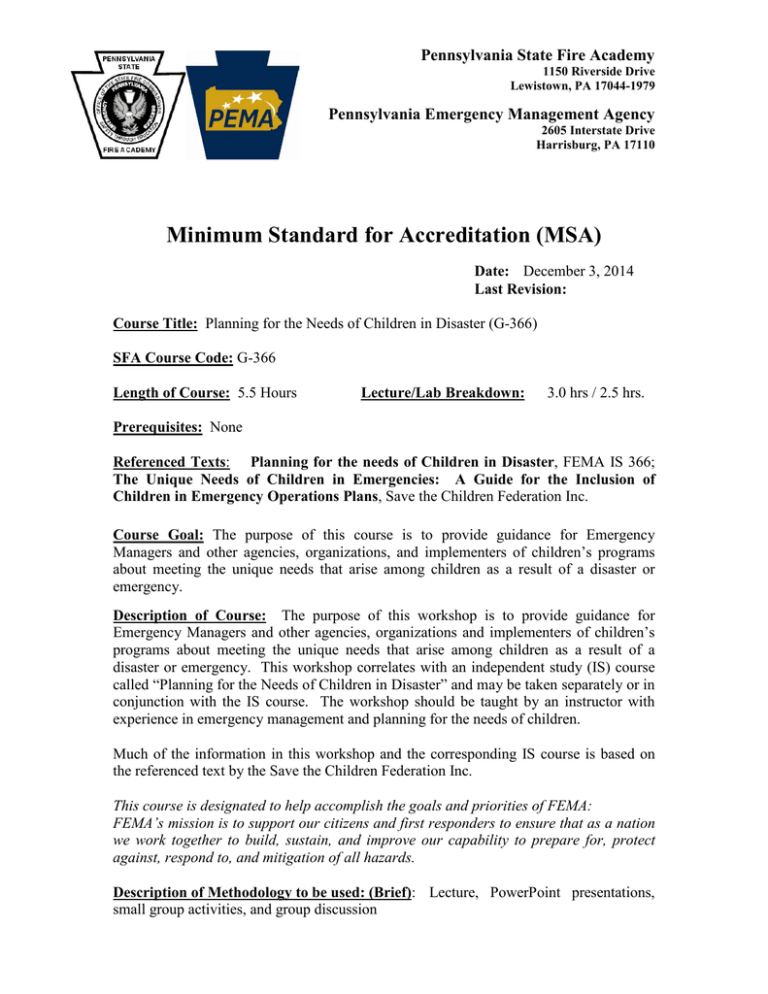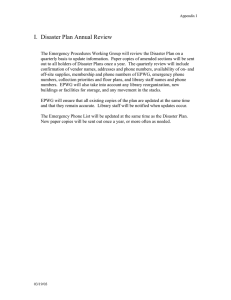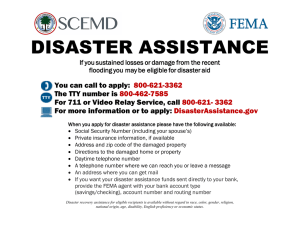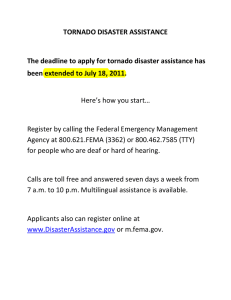Minimum Standard for Accreditation (MSA) Pennsylvania State Fire Academy
advertisement

Pennsylvania State Fire Academy 1150 Riverside Drive Lewistown, PA 17044-1979 Pennsylvania Emergency Management Agency 2605 Interstate Drive Harrisburg, PA 17110 Minimum Standard for Accreditation (MSA) Date: December 3, 2014 Last Revision: Course Title: Planning for the Needs of Children in Disaster (G-366) SFA Course Code: G-366 Length of Course: 5.5 Hours Lecture/Lab Breakdown: 3.0 hrs / 2.5 hrs. Prerequisites: None Referenced Texts: Planning for the needs of Children in Disaster, FEMA IS 366; The Unique Needs of Children in Emergencies: A Guide for the Inclusion of Children in Emergency Operations Plans, Save the Children Federation Inc. Course Goal: The purpose of this course is to provide guidance for Emergency Managers and other agencies, organizations, and implementers of children’s programs about meeting the unique needs that arise among children as a result of a disaster or emergency. Description of Course: The purpose of this workshop is to provide guidance for Emergency Managers and other agencies, organizations and implementers of children’s programs about meeting the unique needs that arise among children as a result of a disaster or emergency. This workshop correlates with an independent study (IS) course called “Planning for the Needs of Children in Disaster” and may be taken separately or in conjunction with the IS course. The workshop should be taught by an instructor with experience in emergency management and planning for the needs of children. Much of the information in this workshop and the corresponding IS course is based on the referenced text by the Save the Children Federation Inc. This course is designated to help accomplish the goals and priorities of FEMA: FEMA’s mission is to support our citizens and first responders to ensure that as a nation we work together to build, sustain, and improve our capability to prepare for, protect against, respond to, and mitigation of all hazards. Description of Methodology to be used: (Brief): Lecture, PowerPoint presentations, small group activities, and group discussion MINIMUM STANDARDS FOR ACCREDITATION G-366 Planning for the Needs of Children in Disaster Page 2 of 3 Student Equipment/Supply Needs: Note taking materials (Pen/Pencil, paper), Student Manual. Equipment/Audiovisual/Supply requirements: Classroom setting with chairs and tables; computer with capabilities to play DVDs, LCD projector screen; additional handouts per instructor choice. Special Notes & Conditions: A class shall consist of a minimum of 10 and maximum of 30 students. Two (2) Instructors are required for this course. COURSE OUTLINE Time 0:30 0:30 0:45 0:45 0:30 0:30 0:30 0:30 0:30 0:30 Content Overview Unit 1: Introduction to Children’s Need Unit 2: Preparing to Meet Children’s Needs Unit 3: Meeting Children’s Needs during Response Unit 4: Helping children Recover from Disaster Unit 5: Mitigating the Effects of Disaster in Children Unit 6: Evaluating a Sample Plan (part 1) Evaluating a Sample Plan (part 2) Summary Evaluation and Final Exam Competency Evaluation Mechanism (Brief description-attach copy): Periodic questioning by instructor throughout presentation and a minimum score of 70% on the post course exam. Course Objectives (specific): At the completion of the course, the participant will be able to: 1. Explain how children’s needs in disaster are unique. 2. Describe the critical components of a child’s world. 3. Explain the importance of coordinated disaster planning effort. 4. Create a list of local organizations to include on a planning team to create the community’s Emergency Operations Plan or to revise the EOP to integrate the unique needs of children. 5. List ways that proper planning can help to ensure that the needs of children are met during emergency response operations. 6. Explain how the unique needs of children can be met in shelters. 7. List four effects of disaster on children. MINIMUM STANDARDS FOR ACCREDITATION G-366 Planning for the Needs of Children in Disaster Page 3 of 3 8. Explain three main priorities for helping children to return to their normal routine and education. 9. Discuss the factors that lead to resilience among children faced with disaster. 10. Explain how demographics information can be used when planning for the needs of children in disaster. 11. Identify funding resources for hazard mitigation. 12. Evaluate an Emergency Operations Plan (EOP) against recommendations in “The Unique Needs of Children in Emergencies.” Questions/Comments: Contact the Assistant State Fire Academy Administrator





